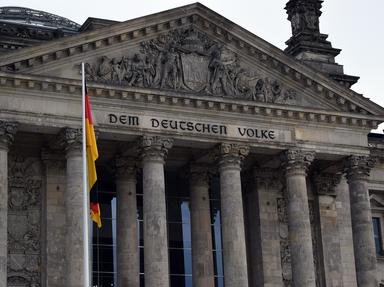Quiz Answer Key and Fun Facts
1. None of the events surrounding the German reunification would have been possible without the Soviet leader who, through his policies of Glasnost and Perestroika initiated a gradual opening process of the Eastern Bloc that soon developed a dynamic of its own. What was the name of this man?
2. The second link in the chain of events happened in May 1989, still not in Germany itself, but in Hungary. What did the Hungarian government do that indirectly set the reunification process into motion by making it possible for East Germans to exploit one of the limited freedoms granted to them?
3. With the Hungarian loophole closed, the focus of the action shifted to Prague, capital of Czechoslovakia. Thousands of East Germans who were dissatisfied with their current situation took a desperate action there, in the hopes of achieving freedom. What did they do?
4. The situation was escalating - where other East European states gradually opened up, East Germany tightened its iron grip on the population. The time was ripe for an uprising, but it didn't come with violence. Instead, people simply took to the streets in weekly, illegal but peaceful demonstrations. On which weekday did these regular demonstrations happen?
5. The weekly demonstrations in East Germany also had one specific motto - a simple sentence that expressed the sentiments of the people towards their people's republic. What was this sentence (in German)?
6. The most important date of the entire East German revolution was ultimately November 9, 1989. On this evening, a fateful miscommunication between the top leadership and border troops in Berlin led to which pivotal event?
7. Just a few weeks after the opening of the border, the last socialist East German government resigned and made room for a freely elected parliament. West and East German political forces pushed towards a fast unification, but to achieve that, a political summit with the victor forces of World War II had to be held. These talks were generally referred to by an arithmetic designation. Which one?
8. Even faster than the actual political reunification, another pressing problem led to a preliminary union taking effect on July 1, 1990. On this day, the two German states adopted a common currency - the Deutsche Mark (DM), formerly used in West Germany only. East Germans needed to exchange their Mark der DDR (M). What ratio was used for this exchange?
9. The actual reunification took place on October 3, 1990 with a great festival in Berlin, around the Brandenburg Gate. Which of the following best describes the process that completed the reunification according to international law?
10. Of course, with the formal unification completed, the actual process of unifying the states' structures had just begun. One of the key aspects that needed to be resolved was that of salaries which were still much higher in the West than in the East. On which date was the last collective agreement between employers and unions ended that still had separate rates for East and West German employees?
Source: Author
WesleyCrusher
This quiz was reviewed by FunTrivia editor
bloomsby before going online.
Any errors found in FunTrivia content are routinely corrected through our feedback system.

